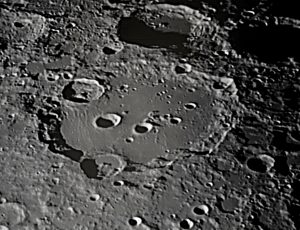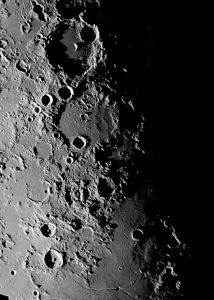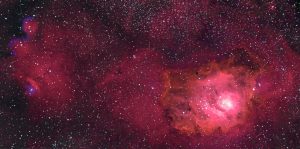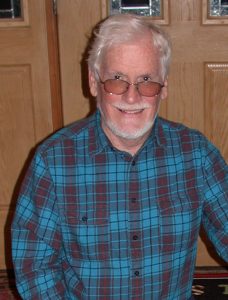Astro-Physics Starfire Refractor> Ever since reading Alan Dyer’s article Astro-Physics Refractors Big & Small in the 1993 September issue of Astronomy magazine, I have dreamt of someday owning an AP-155 f/7 EDF Starfire refractor.
Well, it’s taken a couple of decades but I finally acquired Astro-Physics Starfire Refractor a few months ago, courtesy of one of my oldest astro friends, Terence Dickinson. Terry, as many amateur astronomers will recall, is the author of the bestselling book Night Watch, and along with Alan Dyer, the all-time favorite The Backyard Astronomer’s Guide. Terry was willing to sell me his treasured 6.1” apochromat so that in his words “It can continue to be used under the much clearer and transparent skies you enjoy near Flagstaff, Arizona”. Naturally I did not argue with that!

To quote from Alan’s 1993 review “Optical performance of the 155EDF was impressive. It produced nary a trace of false color even on Venus. Equally impressive, this scope provided superb images as soon as it was set outside. Even in sub-freezing temperatures, image quality, though not perfect at first, was surprisingly sharp from the start. In cold weather, after a modest settle-down time of 30 minutes, in-focus star images were textbook Airy disks with a well-defined first diffraction ring and a trace of a second outer ring. There was no sign of spherical aberration, lens figure changes, heat plumes, or distorted Airy disks due to tube turbulence.”
As stated on the Astro-Physics website with reference to this 1990s vintage scope, the Astro-Physics Starfire Refractor was initially designed for film-based photography, including 35mm and medium format cameras. For the 6×7 film format, it offered an oversized 4” focuser and a 2 element field flattener. This, in combination with the 155mm objective lens tripled, served as a 5 element wide-field f/7 astrograph, with a 3.2 x 3.7 degree field on medium format film.
They go on to say “At the urging of our customers, we also offer the same excellent 155mm f7 lens in a lighter weight tube assembly with our 2.7″ focuser”.

This Astro-Physics Starfire Refractor model can be used photographically with a 35mm (or equivalent format) camera at prime focus or at a fast ~ f5.3 with AP’s optional flat-field telecompressor. My telescope is equipped with the 2.7” focuser and the above reducer-corrector. It is permanently mounted in my observatory on a Losmandy G-11 and coupled piggy-back with a TMB-92 f/5.5 refractor (Fig. 1). I can alternate this rock solid combination as primary imaging instrument and/or guide scope.
Remembering that AP-155 was designed over 20 years ago both for visual work and film-based astrophotography (and sadly is no longer in production), how well does it stand up today? I was especially curious to see how it would perform with my Hutech modified, full-frame Canon 6D, a ZWO ASI-120MC webcam and of course various modern eyepieces.
Visual Performance
I tested the Astro-Physics Starfire Refractor with several of my favorite eyepieces, both 1-1/4 and 2-inch diameter, with and without a quality 2-inch Barlow lens. These included the following: 3.8mm Orion Lanthanum; 8 and 14mm Meade ultra-wide; 24mm Tele Vue Panoptic; 23mm Celestron Luminos 82o; 30mm Explorer Scientific 82o. I even tried a 1980s vintage 12.5mm eyepiece.

As one might expect, the grand old Starfire lived up to full expectations. Its apochromatic triplet consisting of 2 crown and 1 ED elements was essentially color free, exhibiting incredible contrast and exquisite detail on the Moon, Mars, Jupiter and Saturn, all of which have been prominent the past several months. The only hints of extraneous color on the three planets, was atmospheric dispersion due to their low elevation in the sky. That was easily dealt with, however, by inserting a ZWO atmospheric dispersion corrector in front of the eyepiece. On one night of particularly good seeing even the Encke division on Saturn’s well extended rings was easily resolved. Perhaps most pleasing with lunar and planetary viewing was the pastel-like subdued coloration on Jupiter and Saturn.
Likewise with deep sky viewing both at f/7 and f/5.3 with the focal reducer, images were tack sharp with pin point stars and superb contrast under good transparency. Under good seeing, stars exhibited well defined diffraction patterns and test objects like the Double Double in Lyra was an easy target.
Imaging Performance
Since my primary passion and enjoyment is still astrophotography, I was naturally anxious to put the Astro-Physics Starfire Refractor to the test. Having had

an excellent TMB-130 f/7 for many years and recent access to a friend’s AP-150 f/8, of pre-Starfire vintage, I had an ample collection of images for comparison.
Although I am certainly not an accomplished lunar and planetary imager, I recently obtained a ZWO ASI-120MC camera for that purpose. I opted for the color version of this easy to use camera to learn the basics of webcam image capture and processing, and not be encumbered with RGB filter wheels and related requirements.
For lunar imaging I simply use the grayscale option and always shoot through a deep red filter to minimize the effects of atmospheric turbulence. The resultant AVI capture sequences were processed first in AutoStakkert!, sharpened in Registax-6 and finished in Photoshop CS6. In order to obtain the largest practical image size, when seeing is fair to good, I double stack two 2x Barlows, for an effective focal ratio of f/28 and focal length of approximately 4000 mm. If seeing is only fair, a single 2x Barlow is used. The results so far have been most pleasing (Figs 2 & 3).

For deep sky imaging, I use a Hutech modified, full frame Canon 6D, typically in combination with an IDAS LPS-V4 filter. This coupling is particularly well suited for emission nebulae and/or under moderately light polluted skies. Thanks to this camera’s effective noise suppression capabilities, I generally shoot between ISO 3200 and 6400, with 3-5 minute exposure times. A half dozen or more exposures of this duration are then stacked in either Registar or Photoshop.
As can be seen in Fig 4, a mosaic of overlapping images of the Lagoon nebula region taken at f/7 prime focus, stars appear only slightly distorted at the edges of the frame even without a field flattener. At f/5.3 with the reducer-corrector in place, stars are tack sharp to the edge of field and the effective field of view is 1.7 x 2.4 degrees, wide enough to encompass M-31, M-32 and M-110 in the same frame (Fig 5).
So, how well does this nearly 25 year old telescope design perform in the digital age? Superb optics and construction still rank it as top contender by any measure. I have observed and photographed with some of the best telescope designs in my nearly half century as an amateur astronomer, including classics and some of the best modern brands, but have yet to see a better 6-inch apochromatic refractor. Kudos to Roland Christen and Astro-Physics! Might one hope for a sequel?
 Klaus Brasch, Ph.D. is a retired bio-scientist and a public program volunteer at Lowell Observatory. He joined the Royal Astronomical Society of Canada in 1957 and has been an avid amateur astronomer ever since. A frequent contributor to Astronomy Technology Today, JRASC, Sky News and Sky & Telescope, he enjoys astrophotography from his observatory near Flagstaff, Arizona.
Klaus Brasch, Ph.D. is a retired bio-scientist and a public program volunteer at Lowell Observatory. He joined the Royal Astronomical Society of Canada in 1957 and has been an avid amateur astronomer ever since. A frequent contributor to Astronomy Technology Today, JRASC, Sky News and Sky & Telescope, he enjoys astrophotography from his observatory near Flagstaff, Arizona.
And to make it easier for you to get the most extensive telescope and amateur astronomy related news, articles and reviews that are only available in the magazine pages of Astronomy Technology Today, we are offering a 1 year subscription for only $6! Or, for an even better deal, we are offering 2 years for only $9. Click here to get these deals which only will be available for a very limited time. You can also check out a free sample issue here.

